tow YAMAHA XL 1200 2001 Owners Manual
[x] Cancel search | Manufacturer: YAMAHA, Model Year: 2001, Model line: XL 1200, Model: YAMAHA XL 1200 2001Pages: 131, PDF Size: 8.12 MB
Page 21 of 131
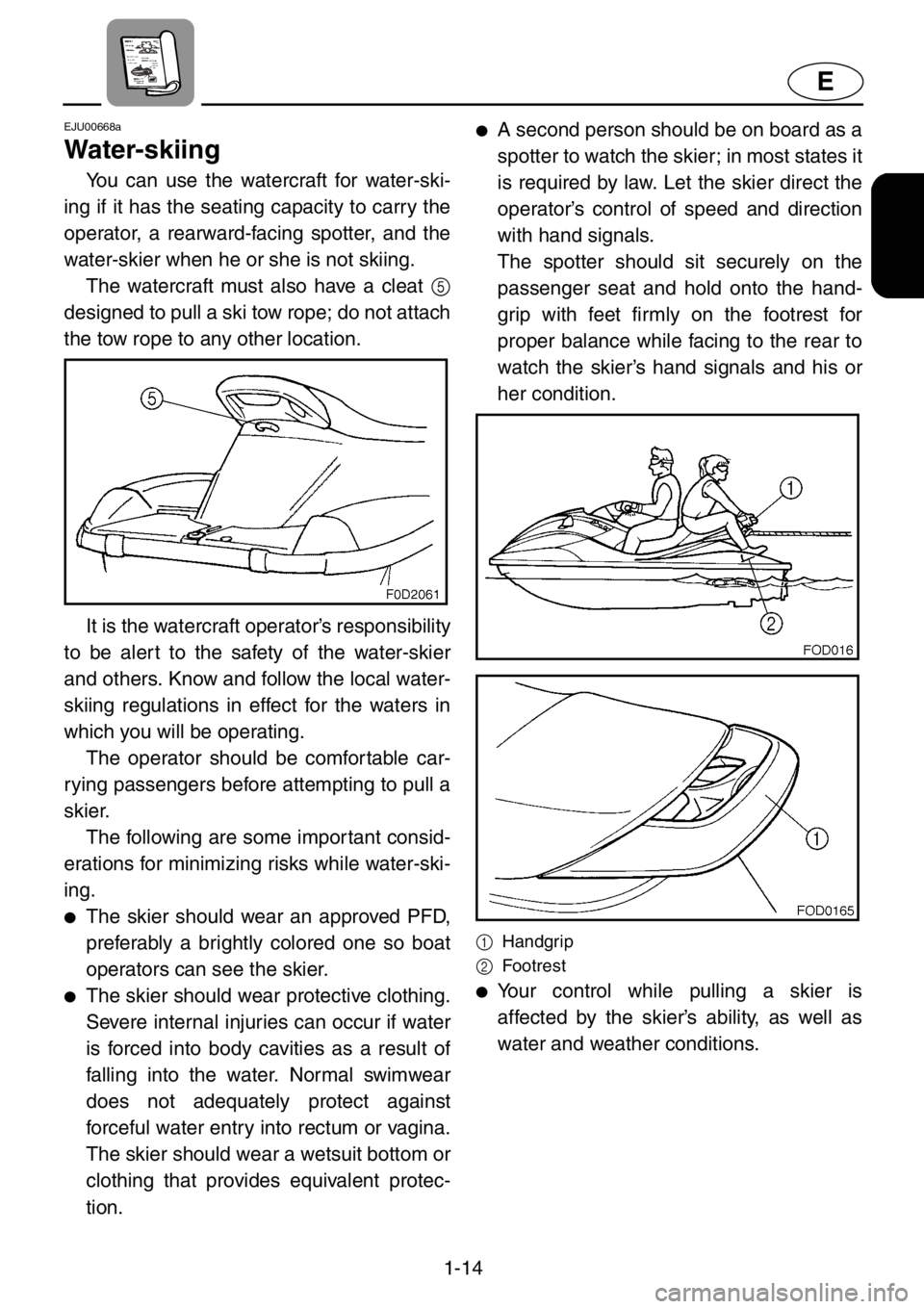
1-14
E
EJU00668a
Water-skiing
You can use the watercraft for water-ski-
ing if it has the seating capacity to carry the
operator, a rearward-facing spotter, and the
water-skier when he or she is not skiing.
The watercraft must also have a cleat 5
designed to pull a ski tow rope; do not attach
the tow rope to any other location.
It is the watercraft operator’s responsibility
to be alert to the safety of the water-skier
and others. Know and follow the local water-
skiing regulations in effect for the waters in
which you will be operating.
The operator should be comfortable car-
rying passengers before attempting to pull a
skier.
The following are some important consid-
erations for minimizing risks while water-ski-
ing.
●The skier should wear an approved PFD,
preferably a brightly colored one so boat
operators can see the skier.
●The skier should wear protective clothing.
Severe internal injuries can occur if water
is forced into body cavities as a result of
falling into the water. Normal swimwear
does not adequately protect against
forceful water entry into rectum or vagina.
The skier should wear a wetsuit bottom or
clothing that provides equivalent protec-
tion.
●A second person should be on board as a
spotter to watch the skier; in most states it
is required by law. Let the skier direct the
operator’s control of speed and direction
with hand signals.
The spotter should sit securely on the
passenger seat and hold onto the hand-
grip with feet firmly on the footrest for
proper balance while facing to the rear to
watch the skier’s hand signals and his or
her condition.
1Handgrip
2Footrest
●Your control while pulling a skier is
affected by the skier’s ability, as well as
water and weather conditions.
Page 22 of 131

1-15
E
●When preparing to pull a skier, operate
the watercraft at the slowest possible
speed until the watercraft is well away
from the skier and slack in the towrope is
taken up. Make sure that the rope is not
looped around anything.
After checking that the skier is ready and
that there is no traffic or other obstacles,
apply enough throttle to raise the skier.
●Make smooth, wide turns. The watercraft
is capable of very sharp turns, which
could exceed the abilities of the skier.
Keep the skier at least 50 m (150 ft),
about twice the distance of a standard
towrope, from any potential hazard.
●Be alert to the hazard of the towrope han-
dle snapping back at the watercraft when
the skier falls or is unable to get up on the
skis.
●Towing heavy or bulky objects other than
skiers, such as another boat or watercraft,
can cause loss of steering control and
create a hazardous condition. If you must
tow another boat in an emergency situa-
tion, operate slowly and cautiously.
EJU00319
Safe boating rules
Your Yamaha watercraft is legally consid-
ered a powerboat. Operation of the water-
craft must be in accordance with the rules
and regulations governing the waterway on
which it is used.
Page 26 of 131
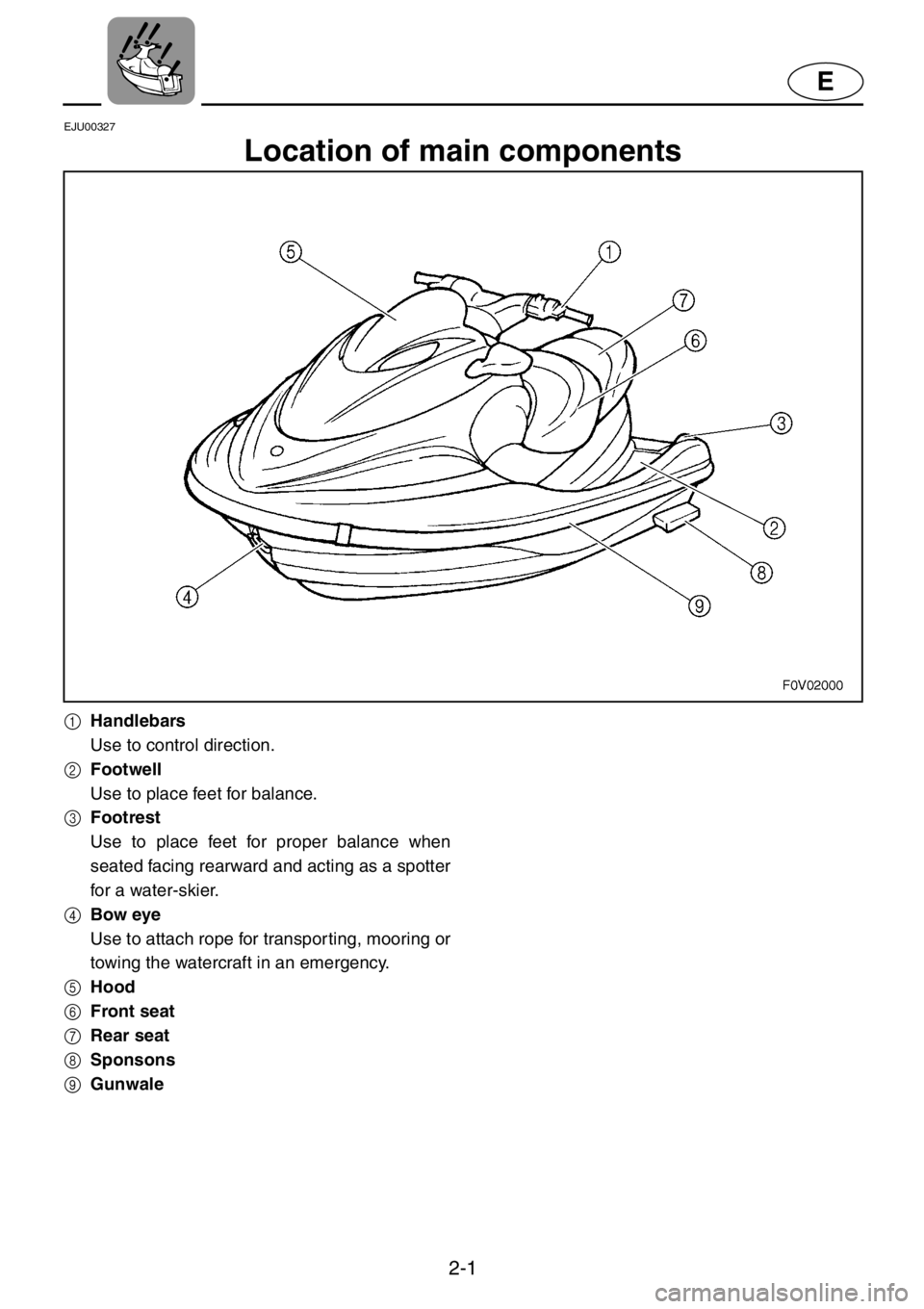
2-1
E
EJU00327
Location of main components
1Handlebars
Use to control direction.
2Footwell
Use to place feet for balance.
3Footrest
Use to place feet for proper balance when
seated facing rearward and acting as a spotter
for a water-skier.
4Bow eye
Use to attach rope for transporting, mooring or
towing the watercraft in an emergency.
5Hood
6Front seat
7Rear seat
8Sponsons
9Gunwale
Page 27 of 131
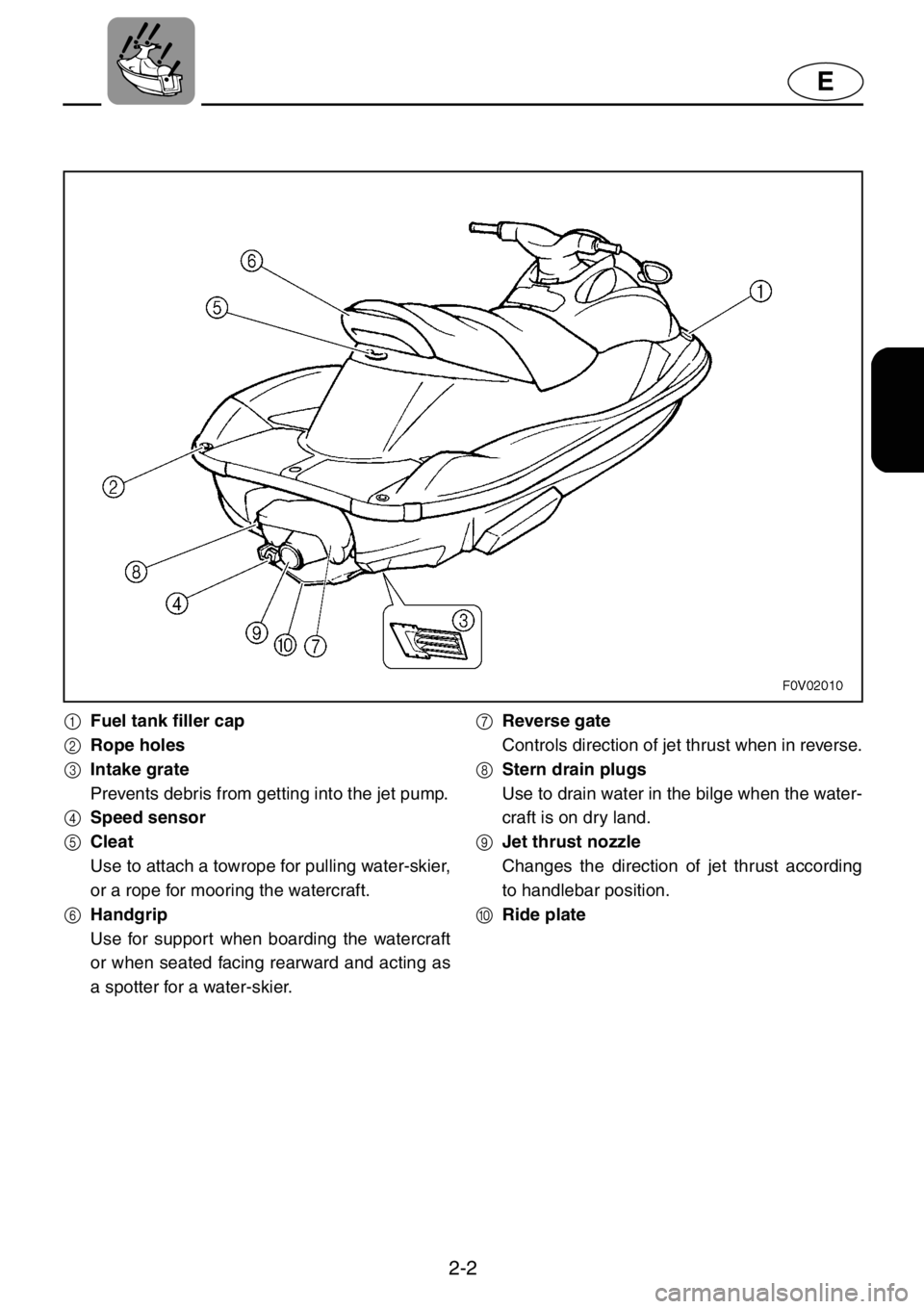
2-2
E
1Fuel tank filler cap
2Rope holes
3Intake grate
Prevents debris from getting into the jet pump.
4Speed sensor
5Cleat
Use to attach a towrope for pulling water-skier,
or a rope for mooring the watercraft.
6Handgrip
Use for support when boarding the watercraft
or when seated facing rearward and acting as
a spotter for a water-skier.7Reverse gate
Controls direction of jet thrust when in reverse.
8Stern drain plugs
Use to drain water in the bilge when the water-
craft is on dry land.
9Jet thrust nozzle
Changes the direction of jet thrust according
to handlebar position.
0Ride plate
Page 39 of 131
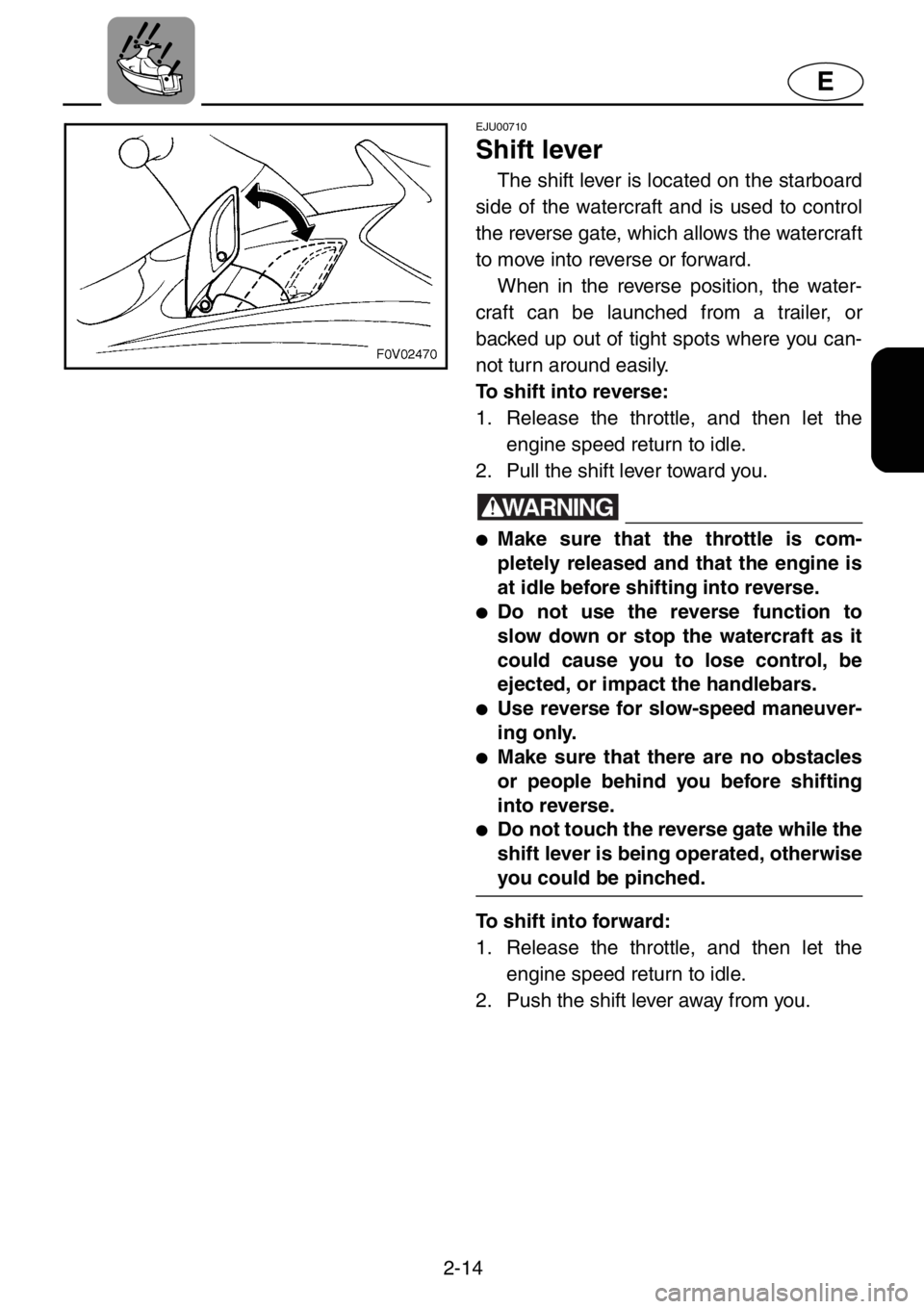
2-14
E
EJU00710
Shift lever
The shift lever is located on the starboard
side of the watercraft and is used to control
the reverse gate, which allows the watercraft
to move into reverse or forward.
When in the reverse position, the water-
craft can be launched from a trailer, or
backed up out of tight spots where you can-
not turn around easily.
To shift into reverse:
1. Release the throttle, and then let the
engine speed return to idle.
2. Pull the shift lever toward you.
WARNING
●Make sure that the throttle is com-
pletely released and that the engine is
at idle before shifting into reverse.
●Do not use the reverse function to
slow down or stop the watercraft as it
could cause you to lose control, be
ejected, or impact the handlebars.
●Use reverse for slow-speed maneuver-
ing only.
●Make sure that there are no obstacles
or people behind you before shifting
into reverse.
●Do not touch the reverse gate while the
shift lever is being operated, otherwise
you could be pinched.
To shift into forward:
1. Release the throttle, and then let the
engine speed return to idle.
2. Push the shift lever away from you.
Page 43 of 131
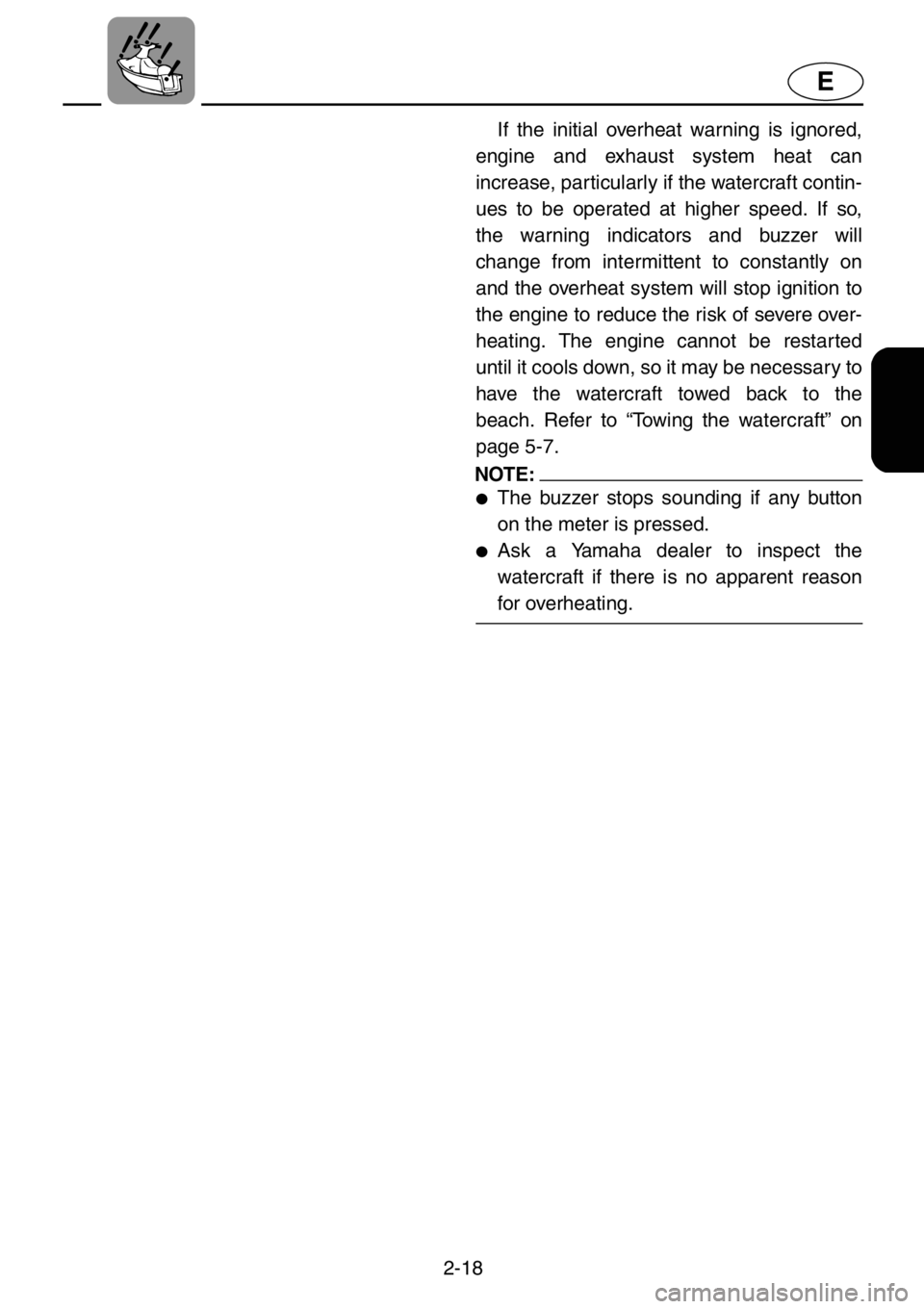
2-18
E
If the initial overheat warning is ignored,
engine and exhaust system heat can
increase, particularly if the watercraft contin-
ues to be operated at higher speed. If so,
the warning indicators and buzzer will
change from intermittent to constantly on
and the overheat system will stop ignition to
the engine to reduce the risk of severe over-
heating. The engine cannot be restarted
until it cools down, so it may be necessary to
have the watercraft towed back to the
beach. Refer to “Towing the watercraft” on
page 5-7.
NOTE:
●The buzzer stops sounding if any button
on the meter is pressed.
●Ask a Yamaha dealer to inspect the
watercraft if there is no apparent reason
for overheating.
Page 44 of 131
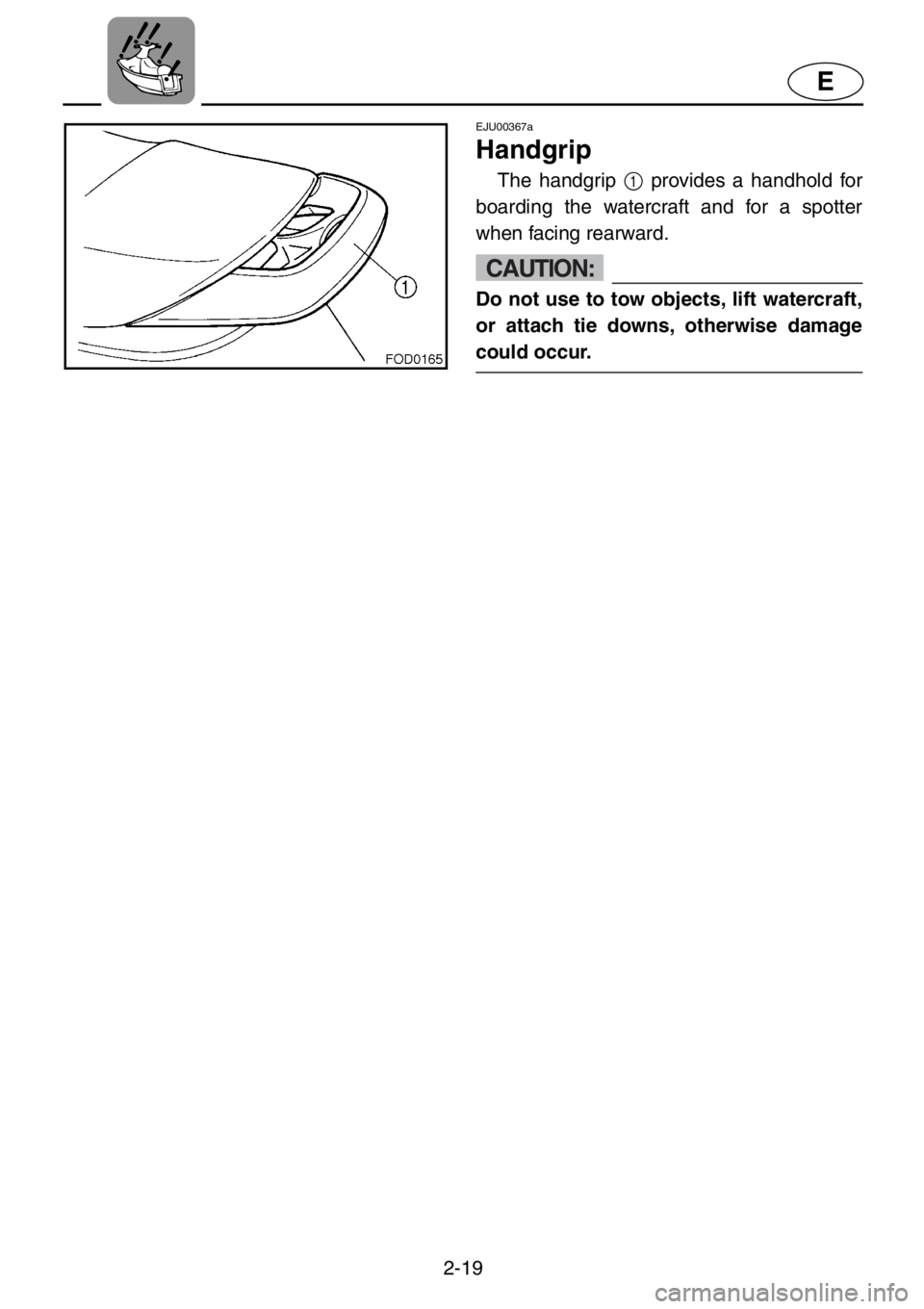
2-19
E
EJU00367a
Handgrip
The handgrip 1 provides a handhold for
boarding the watercraft and for a spotter
when facing rearward.
CAUTION:
Do not use to tow objects, lift watercraft,
or attach tie downs, otherwise damage
could occur.
Page 56 of 131
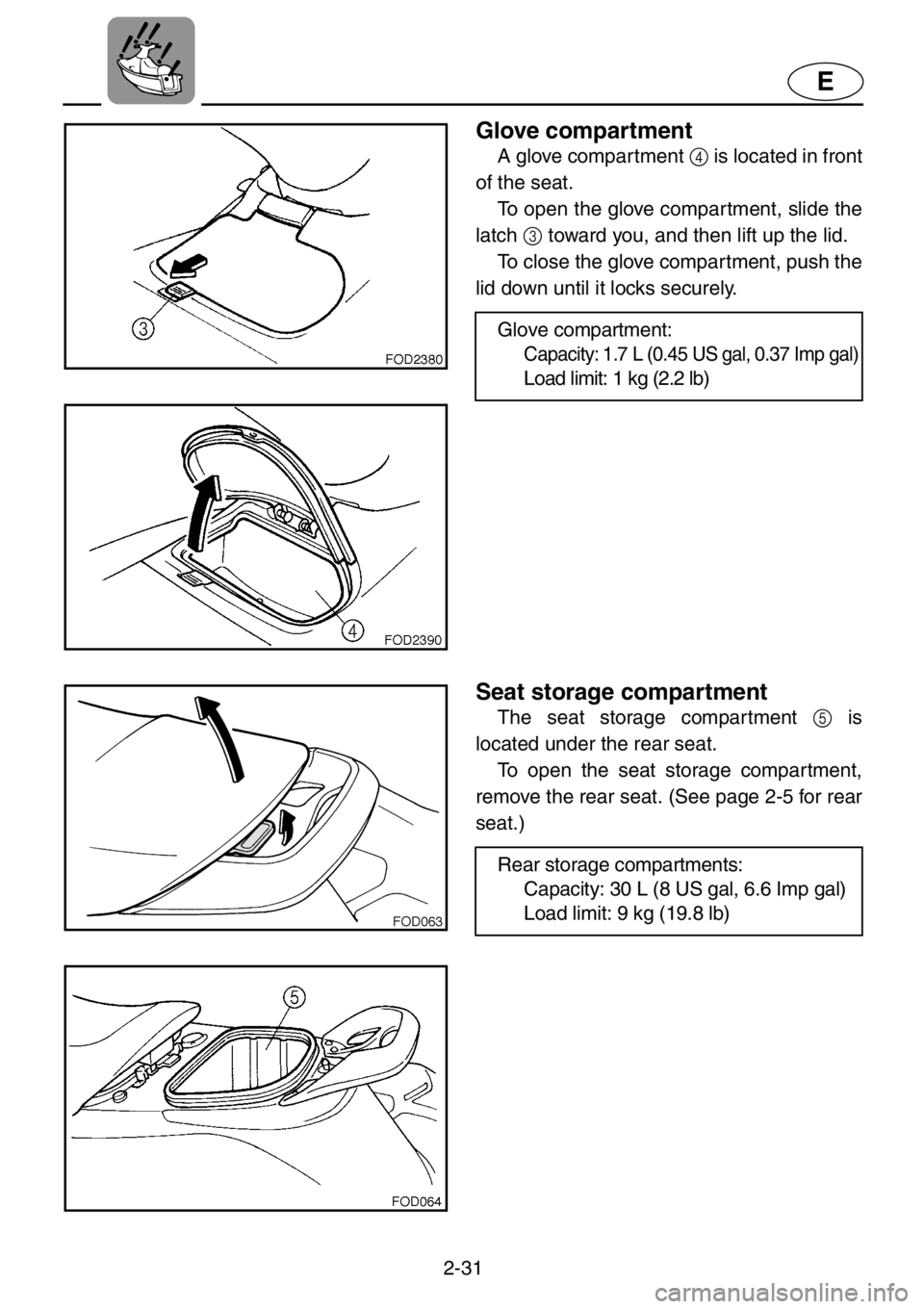
2-31
E
Glove compartment
A glove compartment 4 is located in front
of the seat.
To open the glove compartment, slide the
latch 3 toward you, and then lift up the lid.
To close the glove compartment, push the
lid down until it locks securely.
Glove compartment:
Capacity: 1.7 L (0.45 US gal, 0.37 Imp gal)
Load limit: 1 kg (2.2 lb)
Seat storage compartment
The seat storage compartment 5 is
located under the rear seat.
To open the seat storage compartment,
remove the rear seat. (See page 2-5 for rear
seat.)
Rear storage compartments:
Capacity: 30 L (8 US gal, 6.6 Imp gal)
Load limit: 9 kg (19.8 lb)
Page 92 of 131
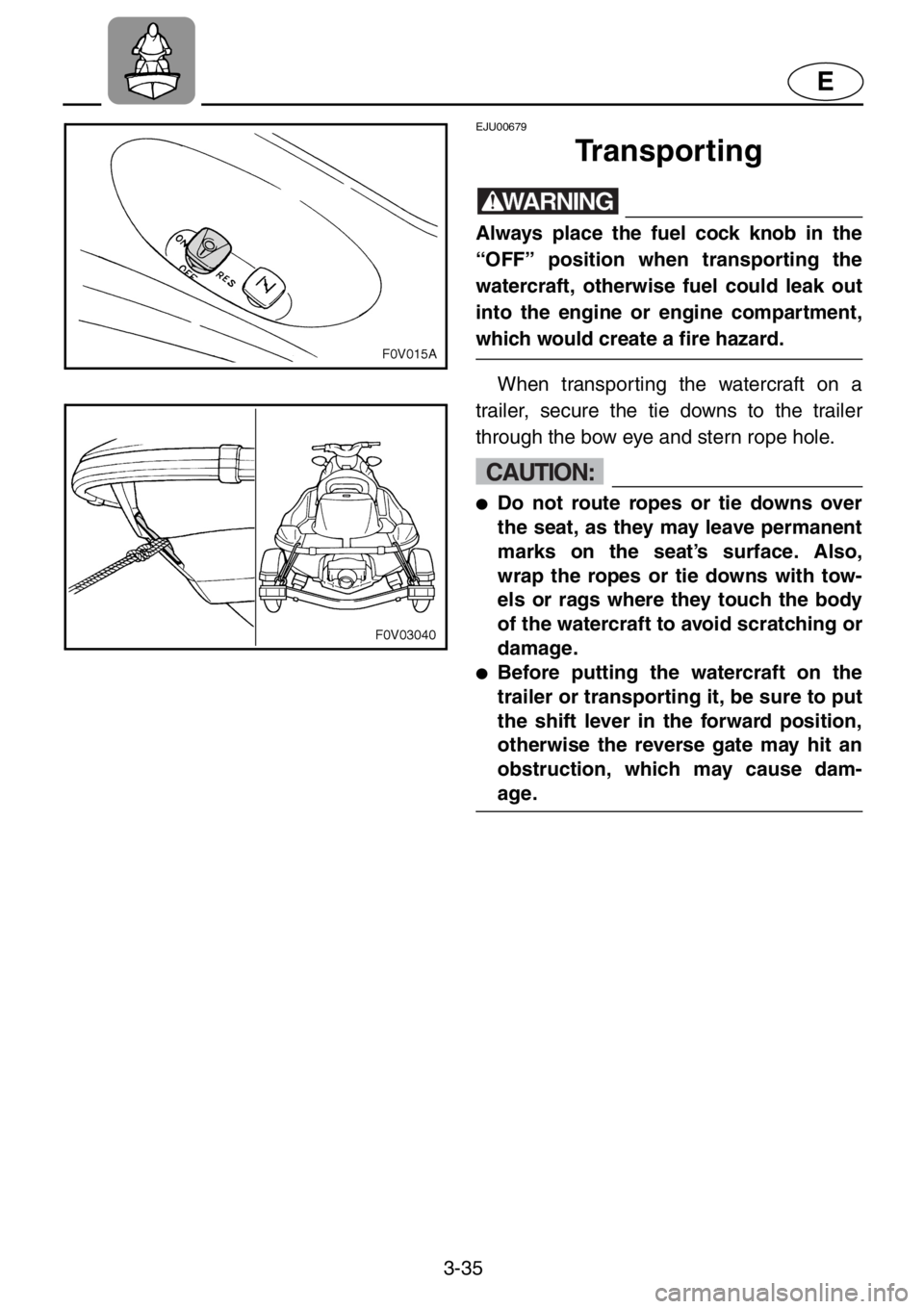
3-35
E
EJU00679
Transporting
WARNING
Always place the fuel cock knob in the
“OFF” position when transporting the
watercraft, otherwise fuel could leak out
into the engine or engine compartment,
which would create a fire hazard.
When transporting the watercraft on a
trailer, secure the tie downs to the trailer
through the bow eye and stern rope hole.
CAUTION:
●Do not route ropes or tie downs over
the seat, as they may leave permanent
marks on the seat’s surface. Also,
wrap the ropes or tie downs with tow-
els or rags where they touch the body
of the watercraft to avoid scratching or
damage.
●Before putting the watercraft on the
trailer or transporting it, be sure to put
the shift lever in the forward position,
otherwise the reverse gate may hit an
obstruction, which may cause dam-
age.
Page 117 of 131

E
5
EJU00594
TROUBLESHOOTING
AND EMERGENCY
PROCEDURES
Troubleshooting....................................... 5-1
Troubleshooting chart ............................. 5-1
Emergency procedures........................... 5-4
Cleaning the jet intake and impeller ....... 5-4
Jumping the battery ................................ 5-5
Towing the watercraft ............................. 5-7
Submerged watercraft ............................ 5-8